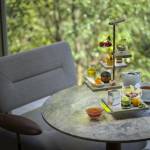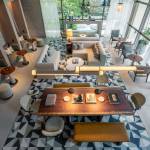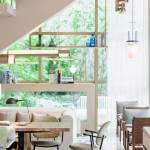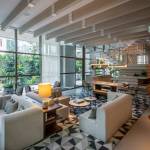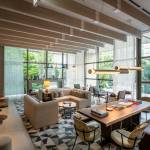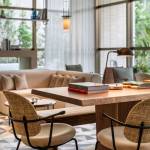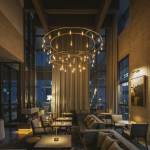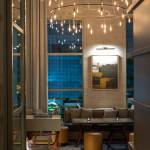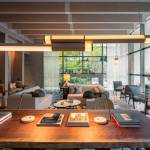As the debut property for this new hotel brand by Palace Hotel Group, and the first project in Japan for one of the world’s foremost interior architectural designers, Zentis Osaka strums a rather singular chord in a city well-known for both its industrious charm and distinctive hospitality. We have heard amazing things about the design elements within the walls of this property, so LuxeGetaways was excited to get an inside look at Zentis Osaka.
Subtly edgy, wonderfully Japanese and naturally resplendent, Osaka’s first addition to the bespoke collection of Design Hotels opened this July with interiors fashioned by UK-based Tara Bernerd & Partners.
“Craftsmanship and industrial heritage are key elements of the local culture, so we sought to encapsulate both through the mixture of materials chosen and the contemporary approach with which we applied them to this project,” explained Bernerd.
The materials: exposed bricks, timber beams, ceppo stone, structural ironmongery and a sculptural, blue-limestone staircase situated at the heart of the arrival experience –complemented by an earthy palette of taupe and ivory, which is accentuated by warm pops of honey, ochre, sage and steel-blue. Light fixtures harkening back to mid-century designs complete Bernerd’s vision for a boutique look that encapsulates industrial chic and approachable luxury.
In the guestrooms, Japanese sensibilities for space utilization are evident in the angular shapes that separate each space much like the interlocking compartments of a bento box, allowing for optimum functionality and a seamless flow throughout. The slender, cool-gray tiles found on the bathroom walls are reminiscent of the fluted Japanese izumo tiles that adorn the hotel’s stylish bar while Shigaraki-yaki tables crafted in the kilns of Shiga, a Japanese prefecture renowned for its pottery, add a sleek touch bedside. Charcoal art in the form of a dramatic, shodo-inspired sweep above each bed – done by local artist Masami Ehara for reproduction as wallpaper – adds an artful flair.
On the main floor, built-in bookshelves frame the elevator doors and hover over the reception desk, showcasing a selection of locally made pottery and other decorative items as well as art books that exemplify local aesthetics. Other titles include coffee-table books celebrating famous foreign artists.
For the inaugural property of the Zentis brand, project developer Mickey Nakane of Media For Space facilitated the collaboration between Palace Hotel Group, Japanese architectural firm Kajima Design and Tara Bernerd & Partners to ensure the development of a distinctive urban oasis.
“For the exterior, we opted for a grid design to reflect the structured nature of business, as the hotel borders the business district of Dojimahama,” said Kouichiro Shiomi, group leader for Kajima Design’s Osaka division. “And then we chose brick, with a predominantly glass façade for the first two levels, to complement the abundance of greenery that surrounds and to soften the building’s overall look. This also gives it a more relaxed vibe, which is more in tune with the entertainment district of Kita-shinchi that the hotel also borders.”
As rare as an entirely new build in a dense part of the city is the fact that the 16-story sanctuary comes replete with an arrival experience that includes entry via a verdant garden setting comprising of indigenous flora such as a Japanese maple as well as a cherry blossom tree.
“The interplay between indoors and outdoors was of particular importance in the street-level lobby and garden space as well as in the dining areas one floor above,” explained Bernerd, who integrated floor-to-ceiling Crittal windows into the design of those spaces to enhance the relationship between them.
On the main floor, a stone and garden terrace interlinked with the Guest Lounge by a double-sided fireplace presents a tranquil outlook while a covered outdoor space on the second floor offers a verdant retreat of its own for those dining at UPSTAIRZ, the hotel’s atmospheric lounge, bar and restaurant in-one.
The connection between inside and out extends to the choice of artwork in the hotel’s reception area, where three prominent pieces are on display. All were inspired by Midosuji, one of the city’s most popular thoroughfares, and each reflects an abstract interpretation of the boulevard as the seasons change – with the largest of them representing autumn, with its blazing gingko leaves. This is a great addition to Osaka!


